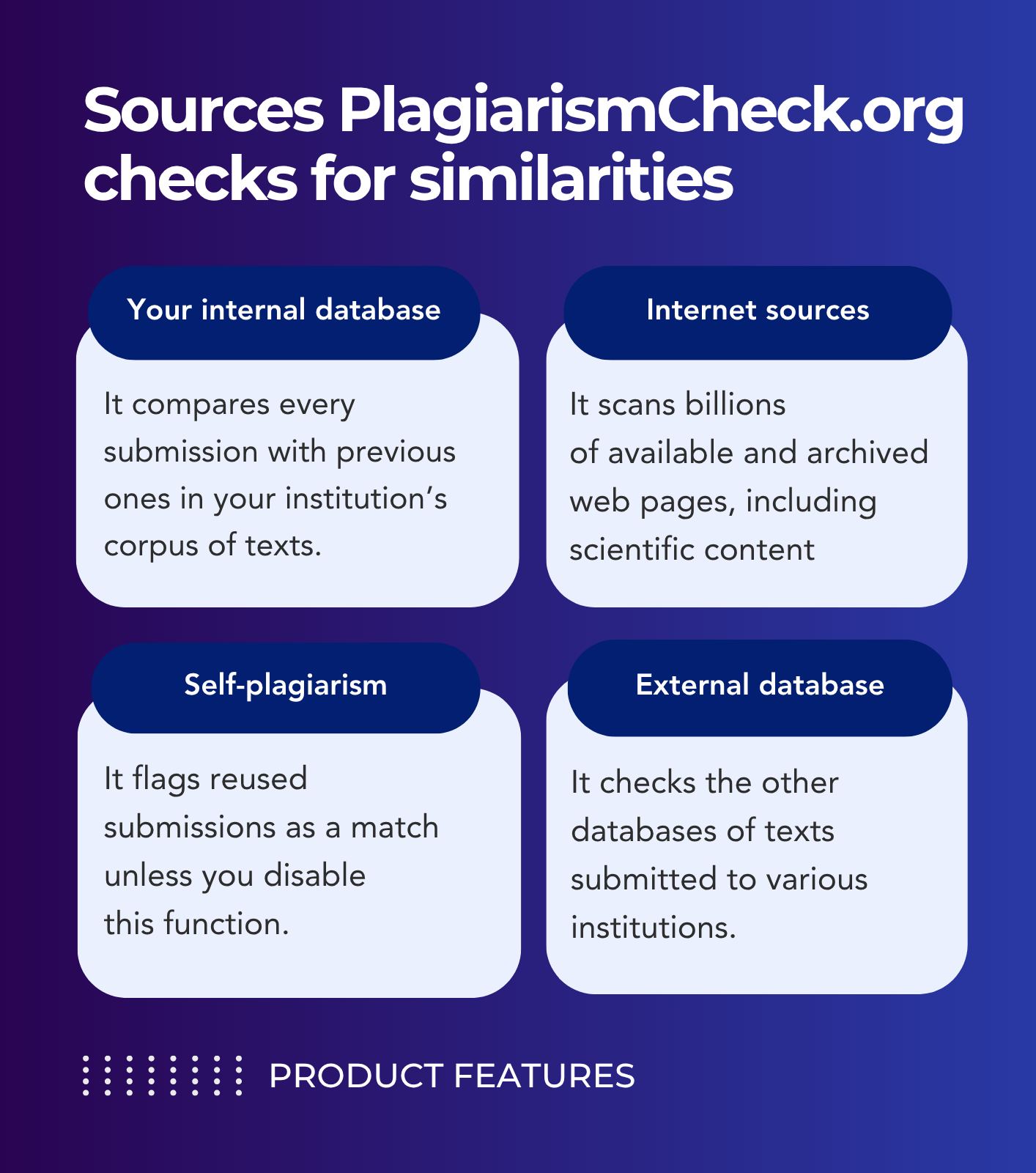A plagiarism check is an essential step for protecting academic integrity and guarding authorship rights. The idea of ensuring that sounds pretty easy. Comparing the text to the sources that can be used for copying, one can conclude whether the content is original or duplicated. However, manually analyzing that giant amount of information demands too many resources. So, that’s when plagiarism-detecting tools come to the rescue.
How do plagiarism checkers work
Plagiarism checkers take on the challenge of comparing the text to available resources and detecting any matching parts. The tool also shows the percentage of similarities. It offers a verdict on whether the writing can be considered plagiarised or original, but it is always up to the human to make the final decision.
- Each plagiarism detector requires a database. Its vastness depends on the product and the customers’ needs. For example, software for teachers may include a repository of academic papers, while a product aimed at editors will contain published journal archives. The more comprehensive the database, the more accurate results the checker provides, as it looks through a larger number of sources. Some tools offer custom repositories, allowing users to upload their own sources for comparison.
- Plagiarism detectors rely on complex algorithms, looking through all the resources online plus through all the content in their repository. They compare the keywords and text extracts and analyze the phrase structure. The advanced detectors also catch replacement words with synonyms and improper paraphrasing attempts.
- The checker calculates the score and generates a report based on the similarities found through the text analysis. Depending on the tool, the output can contain only the percentage of the plagiarism detected in writing or a detailed picture with the highlighted matches and the links to original sources.
AI-based plagiarism checkers
The AI-empowered tool goes deeper than basic text comparison to find exact matches. AI-based plagiarism checkers indicate intricate cases of copying when the words are replaced with synonyms and passive voice is used instead of active, or even when part of the text is translated from other languages.
PlagiarismCheck.org’s advanced AI-based algorithms recognize the following signs of alleged plagiarism:
- exact word-for-word matches;
- substituting words with synonyms;
- sentence structure rearrangement;
- blank symbols usage;
- changing sentence voice from active to passive and vice versa.
Furthermore, the innovative Fingerprint tool for Authorship Verification analyzes the student’s writing style and compares this data to the submitted papers, helping to prevent ghostwriting.

How to use a plagiarism detector
Let’s break down into steps how similarity detection works, using the example of PlagiarismCheck.org.
- Any detector offers to paste the text for scanning on the website. Some tools offer more options. With PlagiarismCheck.org, one can submit a file on the website, scan any web page with a browser extension, or try plagiarism detection on Google Docs with an add-on. Teachers and students can also detect plagiarism with one click in their Learning Management System.
- The tool gives a result after processing the text. With PlagiarismCheck.org, one can run several checks simultaneously, getting a comprehensive report for each piece. The checking process normally takes a few moments.
- The report highlights the parts of the text where the matches have been detected. With PlagiarismCheck.org, one can compare the writing to the original source and make conclusions about whether the piece was plagiarized and how severe the case is. The report is downloadable and printable and can also be shared with others, accelerating feedback and work analysis.
PlagiarismCheck.org FAQ
Is it like Turnitin?
Generally, yes, PlagiarismCheck.org is also a plagiarism detector. However, each tool uses unique algorithms and has peculiarities.
- We offer a deep Internet search, providing accurate real-time results.
- Your data safety is our priority, you are in charge of your texts. If you want to delete them — you can do this anytime.
- Our customers value our fast and responsive support.
What plagiarism score is acceptable?
No universal benchmark regarding the acceptable percentage of alleged plagiarism exists. Our customers’ experience shows that less than 20% are usually considered allowed. However, some teachers and institutions do not approve more than 5% of alleged plagiarism in papers
What is AI percentage?
AI percentage shows the part of the text allegedly generated by AI. So, if you see 20% in the check results, it means that traces of machine-written content were detected in 20% of the paper. Read more on how to interpret AI Detection tool results.
Are AI detectors reliable?
Any AI detector can occasonally deliver false-positive results, as the AI model sometimes resembles human writing, and humans can compose predictable machine-like text. However, advanced algorithms developed by PlagiarismCheck.org ensure 97% accuracy and continue to be improved.
What sources do you check?
PlagiarismCheck.org conducts deep Internet search, including archived content, your institution’s private repository, students’ submissions from various schools, and scientific content in journals. A custom database allows teachers to add resources and papers to avoid submitting already checked works and copying from other students.
How can I be sure my text is safe?
Security is one of our top priorities. Unlike some other plagiarism detection tools, PlagiarismCheck.org never publishes the customers’ texts. You have access to your content in our protected database and can delete it anytime.
How long does it take to get a report?
It takes PlagiarismCheck.org approximately 30 seconds to scan a text up to 20 pages long. You get a comprehensive report immediately after the scanning.
I have a 5-page document, but it shows I have 7. What is wrong?
One page on PlagairismCheck.org contains 275 words. This count may differ from what you see in MS Word or other systems, where the smaller the font is, the more words one page has.
How does your pricing for institutions work?
PlagiarismCheck.org provides two types of subscription plans for institutions:
- per user (student);
- per page.
The educational institution can choose the option that suits their needs. The price starts at $1 per user and contains no hidden costs for integration or training. Integration with popular LMS and unlimited training are included in a per-user subscription.
Does your price include integration and training?
Absolutely! Not only do we have affordable prices compared to other plagiarism detection solutions. PlagiarismCheck.org subscription plan for institutions includes onboarding, 24/7 customer support, a personal account manager, and unlimited training.
PlagiarismCheck.org provides a comprehensive solution for educators, students, and content makers. A similarity detector and AI checker ensure text authenticity, and various integrations and responsive customer support make your user experience smooth and seamless. Join us now!






